 I kapitel 14 i Veletianos antologi Emerging Technologies in Distance Education (2010) skriver Rita Kop om hur man kan använda sociala medier för att öka studenternas lärande och trivsel. Detta kapitel tycker jag är ett av de mest intressanta i boken och jag har därför valt att citera och kommentera mycket ur texten. För att göra det lättare att snabbt hitta de delar av citaten som jag tycker är särskilt intressanta, så har jag kursiverat i dem. Kursiveringarna i citaten är alltså mina och inte original.
I kapitel 14 i Veletianos antologi Emerging Technologies in Distance Education (2010) skriver Rita Kop om hur man kan använda sociala medier för att öka studenternas lärande och trivsel. Detta kapitel tycker jag är ett av de mest intressanta i boken och jag har därför valt att citera och kommentera mycket ur texten. För att göra det lättare att snabbt hitta de delar av citaten som jag tycker är särskilt intressanta, så har jag kursiverat i dem. Kursiveringarna i citaten är alltså mina och inte original. I Rita Kops studie av distansstuderande vuxna ville hon undersöka hur studenter, lärare/handledare och de som arbetar med teknisk support samarbetar och samverkar och hennes syfte är att beskriva möjligheter, svårigheter och förslag till lösningar på problem med Webb 2.0-användning i utbildningen.
I Rita Kops studie av distansstuderande vuxna ville hon undersöka hur studenter, lärare/handledare och de som arbetar med teknisk support samarbetar och samverkar och hennes syfte är att beskriva möjligheter, svårigheter och förslag till lösningar på problem med Webb 2.0-användning i utbildningen.De verktyg som hon fokuserar på är bloggar, video podcasts, wikis och chattar.
Här beskriver hon hur de sociala medierna används i kursen (kursiveringarna är mina):
"the use of Web 2.0 technologies — blogs as reflective journals, wikis for group activities, chat to enhance the affective and social aspects of learning, and pod and video casts by students and tutors — to create a presence and immediacy of interaction. A tutor in this context is the person who is teaching the course, but who has also written the course materials and who has worked with the learning technologist to choose the most appropriate technologies and media to convey the subject knowledge. The chapter will explore the roles of the tutor, learner, and learning technologist in an online learning environment that was initially controlled by the tutor and the institution, and is increasingly adapted to become a place where the learner can feel confident to learn autonomously." (Veletsiano, s 270).
 Hon beskriver särskilt den viktiga funktion som de sociala medierna kan spela. De lämpar sig så bra för kommunikation och hon betonar att kommunikationen är så viktig för själva lärandet och för att studierna ska kännas viktiga, roliga och meningsfulla:
Hon beskriver särskilt den viktiga funktion som de sociala medierna kan spela. De lämpar sig så bra för kommunikation och hon betonar att kommunikationen är så viktig för själva lärandet och för att studierna ska kännas viktiga, roliga och meningsfulla:"identified communication as the most important aspect in making people what they are: “mind, consciousness, thinking, subjectivity, meaning, intelligence, language, rationality, logic, inference, and truth" (Veletsiano, s 270).
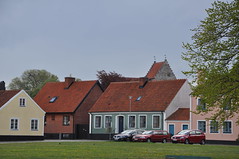 Att kursplattformar och andra lärmiljöer har fått nya verktyg för kommunikation och att de samtal som förs där ofta sedan ligger öppna för alla kursdeltagare att se, skapar nya möjligheter men också nya saker att tänka på och skyldigheter för de lärare som är ansvariga för kursen:
Att kursplattformar och andra lärmiljöer har fått nya verktyg för kommunikation och att de samtal som förs där ofta sedan ligger öppna för alla kursdeltagare att se, skapar nya möjligheter men också nya saker att tänka på och skyldigheter för de lärare som är ansvariga för kursen:"Online communication is quite different from face-to-face communication: online messages may be one-way, the receiver might not know the sender, his or her intentions, or if s/he can be trusted (Kop, 2006). Online communication is a fast connection between systems and networks, conveying messages produced by people. The mediated nature of online communication has been seen as problematic by many practitioners, particularly while using discussion boards in Virtual Learning Environments (VLEs). Issues of power and control, lack of autonomy, high level of tutor support required, and lack of options for personalization, on top of affective issues, have been seen to influence learning in a negative way (Kop, 2006; Mann, 2005; Mason & Weller, 2001). Conrad (2007) noted that some students may be overwhelmed by the number of messages on the discussion board, while other students may experience monologue confessions and tensions in online group activities. Salmon (2004) and Gulati (2006) emphasized the need for quality tutor engagement on discussion boards to cultivate a non-threatening and supportive community. /.../ A good VLE brings information and communication together and offers some structure to the tutor and the “not so technologically adept” learner." (Veletsiano, s 271).
 För att en kurs ska fungera riktigt bra, krävs det ett stort mått av engagemang och deltagande utav såväl elever som lärare i chattar och på forum. Använder man sig dessutom av video podcasts som ett medel för direkt kommunikation mellan lärare och elever så kan man enligt Kop lättare skapa nära relationer:
För att en kurs ska fungera riktigt bra, krävs det ett stort mått av engagemang och deltagande utav såväl elever som lärare i chattar och på forum. Använder man sig dessutom av video podcasts som ett medel för direkt kommunikation mellan lärare och elever så kan man enligt Kop lättare skapa nära relationer:"the more active the engagement in group communication the better. Emerging Web 2.0 technologies facilitate this development as they create an immediacy that has been missing from the VLE (Gur & Wiley, 2007). Podcasts and videocasts could be used to directly speak to tutor and learner, participants in the learning experience, and foster a close connection. Chat has also been highlighted as a powerful tool to create presence and to enhance the social and affective engagement (Carroll, Kop, & Woodward, 2008)." (Veletsiano, s 271f) "the level of emotional engagement and presence being the highest in groups, which would be the typical classroom or distance education student group. Engagement and presence would be lower in online networks (e.g., the blogosphere or large, informal, online courses such as Connectivism and Connective Knowledge 2008/2009 [Siemens & Downes, 2008]); and the lowest in collectives, such as on sharing sites that use tags as connection, such as Flickr for photos, or Delicious for bookmarks. (Veletsiano, s 272).När man skapar virtuella mötesplatser kan man med fördel försöka efterlikna fysiska miljöer såsom till exempel caféer, där människor trivs att vara. I studien framgick att bloggarna och även wikis kunde användas på ett sånt sätt.
"What these physical places have in common is that they are informal and that people feel comfortable being there. People come together and interact in informal places such as doctors’ offices or cafés, and Carroll et al. (2008, p. 3) highlight that “these environments could be transferred to the online space and are well suited to informal online learning, where learning occurs by chance and where participants feel comfortable in building their own presence while communicating with others.”(Veletsiano, s 273)."
 Bloggar passar mycket bra för elever att använda när de tipsar, redovisar, reflekterar, argumenterar och utvecklar sitt självständiga tänkande. Samtidigt är det viktigt att förstå att allt detta inte sker av sig självt, utan att man som lärare måste inspirera och stötta eleverna för att ett positivt och nära studieklimat ska uppstå. Gör man inte det kan bloggarna till och med leda till att eleverna känner sig ännu mer ensamma och utsatta och att deras texter är meningslösa, just därför att de får i uppdrag att göra en massa saker som de sedan aldrig får några reaktioner på.
Bloggar passar mycket bra för elever att använda när de tipsar, redovisar, reflekterar, argumenterar och utvecklar sitt självständiga tänkande. Samtidigt är det viktigt att förstå att allt detta inte sker av sig självt, utan att man som lärare måste inspirera och stötta eleverna för att ett positivt och nära studieklimat ska uppstå. Gör man inte det kan bloggarna till och med leda till att eleverna känner sig ännu mer ensamma och utsatta och att deras texter är meningslösa, just därför att de får i uppdrag att göra en massa saker som de sedan aldrig får några reaktioner på.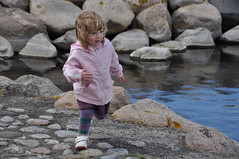 Wikis har framför allt fördelen att man kan använda dem vid planering (brainstorming) och som plats för samarbete och/eller redovisning:
Wikis har framför allt fördelen att man kan använda dem vid planering (brainstorming) och som plats för samarbete och/eller redovisning:"Educators have embraced blogs and wikis as tools for debate and have found out that they work differently from the traditional academic environment. Walker (in Glaser, 2004) notes: Blogging alongside other academics in my field … is a form of indirect collaboration… . There is an openness and a willingness to share in blogging … that means I know more about many of my fellow bloggers’ research than I do about a colleague whose office is down the corridor. (p. 1) Other comments from lecturers and tutors about the use of blogs in their classes include: “the push into critical thinking, critical reading, and reflection” (McIntire-Strasburg, 2004); “the ability to achieve active back-and-forth discussions outside the classroom” (Martin & Taylor, 2004); “Students are blogging about topics that are important to them. Students direct their own learning while receiving input and feedback from others” (Ferdig & Trammell, 2004). Mason (2006) used blogs for peer commenting and saw a high level of reflection as one of the positive effects of blogging as part of a course. On the negative side, Mason also saw blogs’ potential for shallowness and meaninglessness. Lamb (2004) notes the openness of the wiki environment. He sees a number of possibilities to use wikis in an educational context: as spaces for brainstorming; as collaborative areas for teams to work on projects, outlining and managing activities or research; and as repositories of shared knowledge." (Veletsiano, s 274).
 I artikeln skriver Rita Kop även om vilka möjligheter som öppnas i och med att det har blivit så enkelt för såväl lärare som elever att skapa och sprida filmer i undervisnings- eller redovisningssyfte, men att de också de passar bra när man vill försöka skapa en gemenskap och dela med sig av erfarenheter och reflektera:
I artikeln skriver Rita Kop även om vilka möjligheter som öppnas i och med att det har blivit så enkelt för såväl lärare som elever att skapa och sprida filmer i undervisnings- eller redovisningssyfte, men att de också de passar bra när man vill försöka skapa en gemenskap och dela med sig av erfarenheter och reflektera:"While video podcasts seem to have been mainly used to explain difficult concepts, not much research could be found on their use in educational contexts. Kamel Boulos and Wheeler (2007) highlight the possibilities of podcasts in the creation of scenarios in health-care education, while Savel, Goldstein, Perencevich, and Angood (2006) report on the use of podcasts for the fast and cheap delivery of media content. It is through access to broadband, the availability of easy-to-use and freely available audio and video production and distribution software, and the explosion of social video sites, such as YouTube, that students and tutors can more easily become creators and distributors of video content outside the institutional control." (Veletsiano, s 275).
"They used two types of videos: the first one to clarify concepts, and the second to support students — to raise the level of confidence or lessen anxiety at particular moments in the course." (Veletsiano, s 277f).
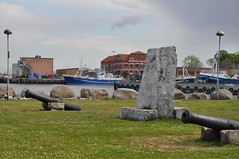 Ett bra sätt att komma igång är att börja en utbildning med ett intensivt och gemensamt kursavsnitt tillsammans på skolan. Då kan man tillsammans systematiskt träna sig i att använda de verktyg som ingår i kursen, bli bra på hur de fungerar och på att avgöra vilket verktyg som passar bäst vid vilket tillfälle. Dessutom menar Kop att detta kursmoment, då man träffades fysiskt och jobbade ihop, bidrog till att man utvecklade en trygghet i gruppen, vilket naturligtvis blev en stor tillgång under resten av utbildningen:
Ett bra sätt att komma igång är att börja en utbildning med ett intensivt och gemensamt kursavsnitt tillsammans på skolan. Då kan man tillsammans systematiskt träna sig i att använda de verktyg som ingår i kursen, bli bra på hur de fungerar och på att avgöra vilket verktyg som passar bäst vid vilket tillfälle. Dessutom menar Kop att detta kursmoment, då man träffades fysiskt och jobbade ihop, bidrog till att man utvecklade en trygghet i gruppen, vilket naturligtvis blev en stor tillgång under resten av utbildningen:"The first module was classroom-based. It was a skills-based course in which learners were made familiar with communication tools such as chat and discussion boards and the application of Web 2.0 tools such as blogs, wikis, and the production of podcasts and videocasts. This was done to ensure a high level of proficiency in using the tools, as it was envisaged that throughout the program these tools would be used for communication and for the submission of assignments. A process of negotiation between tutors, learning technologists, and students was at the heart of the development, as learning technologists and the project manager were the tutors on this first module, while the technologists would provide help-desk support to students during the online modules to ensure that a level of trust was developed from the very beginning. The person responsible for the design of the (Moodle) leaning environment was an expert in Human Computer Interaction, as it was felt that the technology should take into consideration the overall impression, feelings, and interactions that a user has; it is about supporting the creation of relationships with individuals and creating an environment that connects on an emotional level in addition to providing enough opportunities for both the learner and the tutor to create an exciting and dynamic learning experience. Therefore, from the start, the project team has been very aware of the need to design a learning space where people would feel comfortable and in which all participants could have a “presence” (Veletsiano, s 276).
 Tekniken användes i första hand för att understödja relationsbyggande och bidra till att skapa närhet och närvarokänsla. Här kan du läsa lite mer konkret om hur kursverktygen och kursmaterialen såg ut. Kop berättar att olika verktyg lämpade sig olika bra för olika saker och att det fungerade bäst när man kombinerade dem. Hon pekar också på att en del lärare hade en särskilt god förmåga att via kommentarer på elevernas individuella reflektionsbloggar öka elevernas självförtroende, kunskaper och motivation:
Tekniken användes i första hand för att understödja relationsbyggande och bidra till att skapa närhet och närvarokänsla. Här kan du läsa lite mer konkret om hur kursverktygen och kursmaterialen såg ut. Kop berättar att olika verktyg lämpade sig olika bra för olika saker och att det fungerade bäst när man kombinerade dem. Hon pekar också på att en del lärare hade en särskilt god förmåga att via kommentarer på elevernas individuella reflektionsbloggar öka elevernas självförtroende, kunskaper och motivation:"In the online place, several communication tools were used to create a sense of presence and for social engagement. These were “the lounge” (an informal place in which participants could chat, watch a courserelated video, or give each other links to materials and information), discussion boards, chat spaces, wikis, podcasts, and blogs in the form of reflective diaries. It was quite often the combination of tools used that made for a quality learning experience. Clearly some tools are better than others at enabling the provision of individual feedback, while others are better at facilitating group work, or to ensure the social interaction of a group of students. In this program, blogs were used as reflective diaries, which were used extensively. Students were very open and honest in what they wrote about their learning experience. The tutors used the comment feature to give students personal feedback. Some tutors were particularly good at providing feedback, and on one particular course, it was clear that the students’ confidence levels and their knowledge and eagerness to participate increased because of the personal approach to feedback in the diaries." (Veletsiano, s 277).Lärarna kunde dessutom spela en viktig roll i hur gemenskapen på kursen utvecklades, bland annat genom hur personliga och spontana de själva vågade att vara:
"Tutors required a high level of reflection on the learning and teaching taking place in the course, in addition to being willing to show themselves as real human beings, rather than as distantly removed tutors, as the videos were very personal accounts and observations about the course progress. Videos of this nature, made on the spur of the moment, were very much appreciated by students, who said the immediacy that the videos created made them feel they were part of a group of people they felt close to. This also led to students themselves responding with videos in different situations, as part of discussions or to reveal more about themselves." (Veletsiano, s 278).
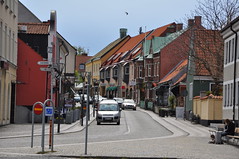 Just wikis kan vara lite svåra för studenter att förstå till en början och de tycker ofta att det känns obekvämt att ändra i andras texter. För att man ska komma förbi detta motstånd och verkligen uppnå det där samskrivandet som man vill att wikis ska användas till, så kan man som lärare aktivt gå in och leva som man lär. Börjar läraren gå in och redigera eller lägga till i andras texter, så vågar eleverna också i större utsträckning:
Just wikis kan vara lite svåra för studenter att förstå till en början och de tycker ofta att det känns obekvämt att ändra i andras texter. För att man ska komma förbi detta motstånd och verkligen uppnå det där samskrivandet som man vill att wikis ska användas till, så kan man som lärare aktivt gå in och leva som man lär. Börjar läraren gå in och redigera eller lägga till i andras texter, så vågar eleverna också i större utsträckning:"Wikis are seen to be valuable in carrying out collaborative activities involving the creation of a joint piece of work, but in the program this rarely worked well. The adult learners weren’t used to the concept of “collaborative knowledge creation,” and in most cases preferred to see visibly what their contribution to the learning task had been, rather than for it to become a joint venture. This resulted in discussion-board style participation. The idea of making changes to contributions by others was alien to students and they did not feel comfortable doing this. Lamb (2004) and James (2004) argue that for wikis to work well, the control should be handed over to the learners, but even though most of the students on the course were young adults, they didn’t feel at ease at all with shaping documents collaboratively, in particular in tasks involving developing concepts, rather than more practical tasks. It was not until the tutor became involved and showed that it would be fine to make changes to the document by doing so herself, while also reinforcing the ground rules about using wikis, that students would engage collaboratively in producing a document." (Veletsiano, s 278).Kops studie visade att särskilt chatten och de individuella bloggarna gjorde att det skapades nära relationer på kursen och att lärarna upplevde att de lärde känna sina elever väl. Kop noterade också att det behövdes att lärarna visade ett genuint intresse för sina elever och deras lärande för att de skulle känna sig trygga och kompetenta:
"Extensive use of weekly chats has been made in all modules, especially to create a sense of “togetherness” and to facilitate social interaction. After using a variety of Web 2.0 tools and more traditional ones such as discussion boards, all tutors involved mentioned that they had a good feel for who the students were as persons. The use of the chat tool and the reflective diaries in particular helped to foster affective relations. This research indicates that before adult learners feel confident enough to venture to engage in online networks in order to find information and to communicate, they first need nurturing by a tutor who is genuinely interested in them as persons and in their learning.” (Veletsiano, s 279).
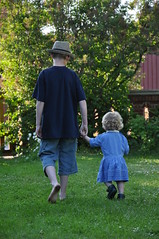 Avslutningsvis hävdar Rita Kop att kommunikation och relationer med andra studenter och lärare är grunden för en lyckad distanskurs och att kursen fungerar bäst om man kombinerar flera olika sociala medier, såsom till exempel bloggar och wikis med chattar och video podcasts:
Avslutningsvis hävdar Rita Kop att kommunikation och relationer med andra studenter och lärare är grunden för en lyckad distanskurs och att kursen fungerar bäst om man kombinerar flera olika sociala medier, såsom till exempel bloggar och wikis med chattar och video podcasts:"This research has shown that communication and interaction with other learners and with tutors is at the heart of a quality online learning experience, and that this mixed use of multi-sensory Web 2.0 tools in a flexible manner, “if and when required,” can be very powerful. By creating an online place where people feel comfortable and relaxed, a place that affords communication and interaction at different levels and while using a variety of tools, both tutors and students develop a strong sense of presence that can help participants gain confidence in both their learning and teaching. The direct interaction between the designers and writers of content and the learners in an environment that allows for affective involvement and “transactional nearness” ensures that meaningful activities are created and meaningful communication can take place." (Veletsiano, s 280).
 Själv undervisar jag inte alls på distans, utan träffar alla mina elever regelbundet. Ändå tycker jag att dessa tankar kring sociala medier och distansundervisning passar jättebra även för mitt sätt att jobba. Även om man även träffas i det fysiska rummet, så tror jag att studierna blir roligare och mer engagerande om vi även skapar välfungerande lärmiljöer på nätet, platser där våra elever kan dela med sig och ta del av, inspirera och inspireras, reflektera och ge respons och, sist men inte minst, diskutera.
Själv undervisar jag inte alls på distans, utan träffar alla mina elever regelbundet. Ändå tycker jag att dessa tankar kring sociala medier och distansundervisning passar jättebra även för mitt sätt att jobba. Även om man även träffas i det fysiska rummet, så tror jag att studierna blir roligare och mer engagerande om vi även skapar välfungerande lärmiljöer på nätet, platser där våra elever kan dela med sig och ta del av, inspirera och inspireras, reflektera och ge respons och, sist men inte minst, diskutera.







Inga kommentarer:
Skicka en kommentar